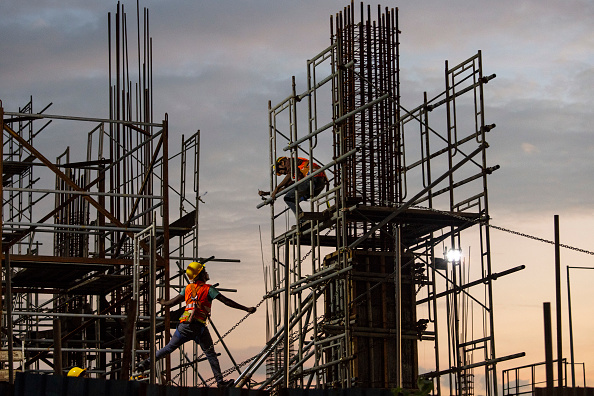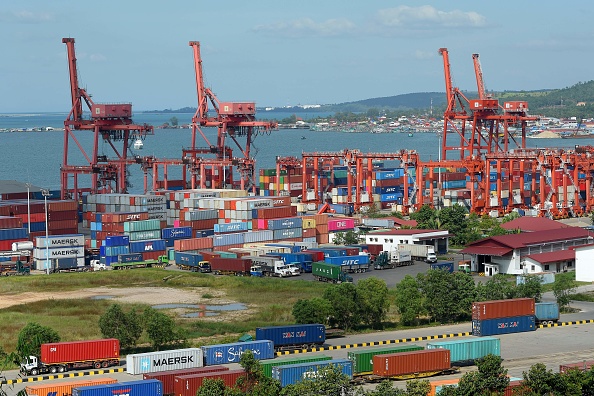“What we hope to create,” he said, “is a big family of harmonious coexistence.”
Yet the effects of BRI have been anything but harmonious. Chinese-backed railway projects in Indonesia, Malaysia, and Thailand have stalled, as Beijing’s partner governments have complained about excessive costs, corruption, and what Malaysian Prime Minister Mahathir bin Mohamad has termed “a new version of colonialism.” Analysts have criticized Beijing for practicing “debt-trap diplomacy”—using BRI as cover to extend astronomical loans that will leave its partners beholden to Chinese interests. American diplomats routinely accuse Beijing of “predatory lending,” and last October, U.S. Secretary of State Mike Pompeo referred to BRI as a Chinese attempt to buy an “empire.”
There is one problem with the current hysteria surrounding BRI: nobody, including in Beijing, knows what BRI really is. In his 2017 keynote, Xi described “the project of the century” as encompassing nearly everything: finance, infrastructure, innovation, trade, transportation, sustainability, and people-to-people connectivity. The Chinese government has never provided an official definition of what constitutes a BRI project, nor has it issued a list of approved BRI participants. As a result, Chinese interest groups of all stripes—local governments, state-owned corporations, private enterprises, universities, and even charities and nongovernmental organizations—have been able to claim that their pet projects are a part of BRI, whether or not they have official government support. BRI may be the most talked about and least defined buzzword of this decade.
China is currently attempting to revamp and rebrand BRI in response to global criticism. To do so successfully, it will have to clarify the purpose, priorities, and scope of the initiative. It should define specific BRI projects, allowing only those that meet sufficiently high standards of quality, transparency, and accountability to claim the initiative’s mantle. By removing the confusion around BRI, China may begin to regain the trust of the international community while heading off speculations that have recently tarnished the image of Xi’s signature project.
UNDERSTANDING BRI
BRI has always been hazily defined. A 2017 essay published in China Daily offers a sense of the official language that has typically surrounded the initiative. According to the authors, both Chinese policy advisers based at Tsinghua University, BRI represents “the integration of spiritual and material human abilities to understand the world, change the world, and profoundly shape the destiny of humanity.” What this is supposed to mean in policy terms is an enigma, to say the least.
Theoretical vagueness translates, on the ground, into practical confusion. Let me offer a concrete example from my research in Sihanoukville, a beach town in Cambodia that has become a symbol of contention over BRI. In recent years, this town of 150,000 residents has seen an influx of Chinese workers, contractors, and tourists, not to mention a deluge of Chinese investment—$1.1 billion in 2018 alone. Casinos and condos have cropped up everywhere. Existing infrastructure can hardly keep up with the frantic pace of construction: the town’s streets are covered with accumulated garbage and flooded with water from burst pipes. Although a minority of local residents profit immensely by renting out properties to Chinese investors, many others have been crowded out by soaring prices. The result has been a rise in anti-Chinese sentiments. For Cambodians—as well as the international media—all of these disruptions fall under the heading of BRI.
Yet for all the Chinese money and investors in Sihanoukville, only a few projects there are definitively part of BRI, understood in the narrow sense as projects funded by the Chinese state in order to promote bilateral cooperation or development. One such project is an expressway, currently under construction, linking Sihanoukville to the capital city of Phnom Penh. State-backed Chinese loans finance the road, at a projected $2 billion, and a state-owned Chinese company is building it. Xinhua, the official Chinese news agency, has declared the expressway “a key project under BRI cooperation.”
Yet other projects are more ambiguous, such as the Sihanoukville Special Economic Zone (SSEZ), an industrial park that employs about 20,000 workers. On its website, the Chinese Ministry of Commerce describes SSEZ as “an important cooperation project between Cambodia and China,” but unlike the expressway, it is a joint venture between private Cambodian and Chinese companies.
Even less directly connected to BRI are the Chinese casinos and condos that now fill Sihanoukville. These are mostly private investments seeking quick profit and speculative gains, rather than projects to promote development or improve ties between Beijing and Phnom Penh. And not all the investment comes from the mainland: some of the investors in Sihanoukville are from Hong Kong, Macau, and Malaysia. But local residents often do not distinguish between state and private investment or among ethnically Chinese investors from different countries—in their eyes, if it’s Chinese, it’s BRI.
Ambiguity about what does and does not count as a BRI project goes beyond single cases such as Sihanoukville; it also affects databases that foreign analysts use to track BRI. The data set constructed by the Center for Global Development, for instance, relies on Chinese media publications to identify BRI projects, leaving out smaller projects not profiled by the media. The China-Africa Loan Database measures Chinese loans to Africa, excluding investment and privately funded projects. The Reconnecting Asia Database covers major infrastructure projects in Asia yet omits industrial parks such as the SSEZ. The wide range of definitions adopted by analysts of BRI has led the political scientist Nick Bisley to argue that “China’s sprawling infrastructure program has become a test of attitudes that tells us more about the analyst than BRI.”

The confusion surrounding BRI defies a stereotype of China’s leadership as strategic and coherent. Because China is an autocracy, many assume that its leaders formulate farsighted grand strategies, which subordinates work to faithfully execute. The reality is typically the opposite. National agendas are formulated at the top and proclaimed by leaders, often using proverbs and analogies (think former Paramount Leader Deng Xiaoping’s signature slogan, “Crossing the river by touching the stones”). Yet implementation is left to a litany of committees, ministries, and local governments, which are tasked with translating the grand vision into concrete policies and projects. This arrangement makes it easy for domestic interest groups to use a national policy as cover to pursue their own agenda, for instance by creating BRI projects to secure procurement deals and cheap loans.
As BRI is only six years old, its formulation naturally extends upon domestic-policy-making traditions. One of these traditions is the “policy campaign.” Whereas technocratic democracies pass laws and then implement them in a routine manner, China tends to make policies in a “campaign” style, in which the top commander mobilizes bureaucrats, entrepreneurs, and even ordinary citizens toward a single vision. These campaigns have the advantage of inspiring mass participation and achieving quick results, but the scale and speed of the action they inspire, combined with a lack of coordination, usually produce a string of blunders. When problems grow too serious to ignore, the leadership is forced to adjust. BRI displays the characteristic pattern of such a campaign: vision setting, mass mobilization, and subsequent recalibration.
Another domestic-policy-making tradition, as my own research shows, is deliberate ambiguity. Chinese leaders often speak—and formulate directives—in vague or even cryptic terms. For example, the central guiding document for BRI from 2015 to 2017 was only seven pages long and sketched broad principles such as “go where the demand is” and “share responsibilities and progress together,” rather than providing a detailed plan. Ambiguity leaves policies open to interpretation, allowing them to be adapted to different conditions and gradually fine-tuned as leaders figure out their plans. But when this deliberate ambiguity is carried over into the formulation of a sweeping global policy such as BRI, it creates misunderstandings overseas that lie beyond Beijing’s anticipation or control.
Countries that participate in BRI, for instance, do not know whether the initiative is primarily about building infrastructure, promoting trade, extending Chinese loans, establishing new standards, or broadcasting Chinese soft power. They cannot enforce accountability because they cannot evaluate BRI projects according to their purported aims. Indeed, they do not even know for certain which projects fall under BRI. This vagueness provides fertile ground for suspicion and speculation, such as claims that China deliberately wants BRI projects to fail in order to seize strategic assets from debtors.
Beijing’s failure to manage BRI’s brand has also emboldened opportunists within China to take advantage of the initiative for self-promotion and enrichment, with global consequences. In June 2017, the party committee on BRI met to discuss precisely this problem: “misusing BRI to extract profits.” It gave a list of examples: some companies appropriated BRI’s name to advertise financial products and investment funds; others organized so-called BRI conventions to raise funds and charge exorbitant fees; and a few even created fake websites that imitated the official BRI website in order to drum up business. These misuses, said the committee, have harmed the initiative’s brand overseas.

THE ROAD AHEAD
Facing a global outcry over BRI, Beijing is now shifting gears from a hazily defined BRI 1.0 to a more fine-tuned BRI 2.0. At a 2018 symposium marking the fifth year of BRI, Xi described this transition, using an analogy from Chinese painting, as a switch from xieyi, freehand painting for outlining broad strokes, to gongbi, the careful inscription of details. Revealingly, during his April speech at the second BRI forum, Xi used two new keywords that were absent from his speech at the 2017 forum: “priorities” and “execution.” He dropped the phrase “the project of the century.”
If China is serious about improving BRI, however, it will need to go beyond a change in rhetoric and take at least three concrete steps. The first, already implicit in Xi’s speech, is to choose its priorities. BRI cannot be everything. Beijing needs to narrow down its objectives and focus on achieving them. Three priorities stood out at the 2019 forum: open consultation, clean governance, and green (environmentally friendly) projects.
Along with narrowing its priorities, Beijing must take steps to clarify the scope of BRI. It should establish standards of quality, transparency, and accountability and issue an official list of BRI projects that meet these standards. Chinese policymakers may already be planning this move: in April, Bloomberg reported that Beijing was drafting rules for which projects should be considered part of BRI and “working on a list of legitimate Belt and Road Initiative projects officially acknowledged by the Chinese government.”
Finally, China should seek to improve the quality of BRI by working with other countries to develop pilot projects. Sihanoukville, for example, could benefit from a relatively low-cost pilot to fix broken roads that focused on consulting with local communities. These pilots would test out policies on a small scale, generating lessons that can then be scaled up to larger projects. Reform-era China has long used pilots to experiment with domestic policies, as it did in 1980 with the creation of a special economic zone in Shenzhen. In the context of BRI, such small-scale experimentation will allow Beijing to discover what works before sinking money and diplomatic capital into more ambitious projects. In fact, the principle of using pilots to “scale from point to surface” was already highlighted in Beijing’s 2015–17 guiding document on BRI, but it has not yet been implemented.
Chinese leaders who invoke history as a guide need not go as far back as the age of the Silk Road. They should instead look to the more recent past. China rose from an impoverished communist country to a capitalist superpower on the strength of its pragmatism and adaptability—the two qualities that should guide BRI 2.0.






